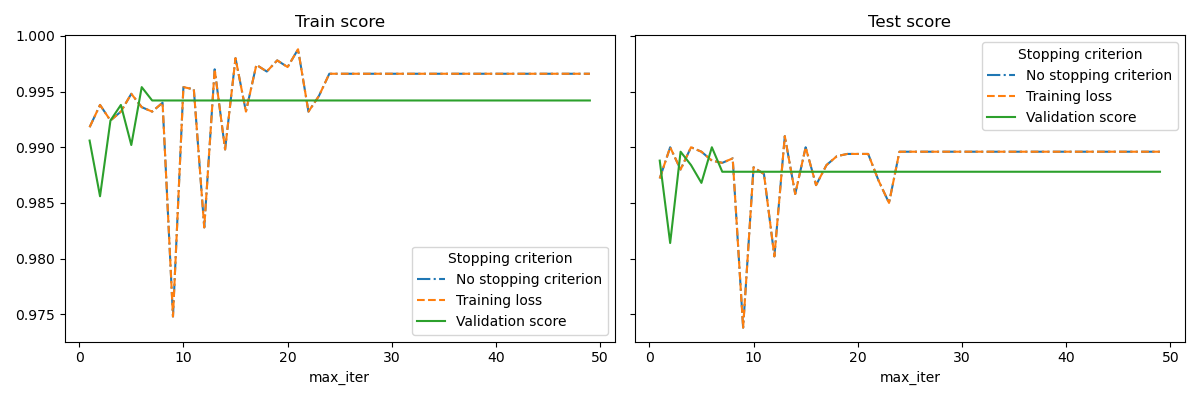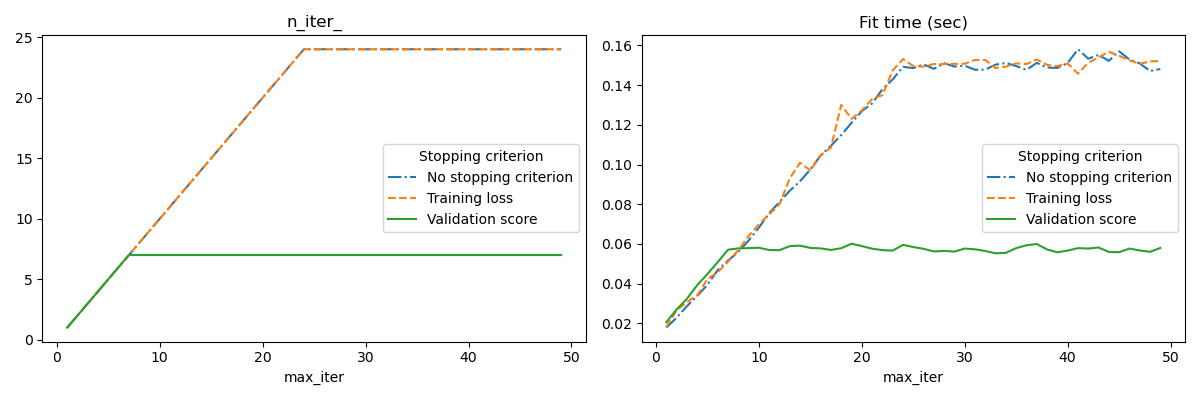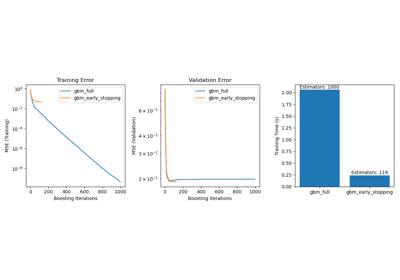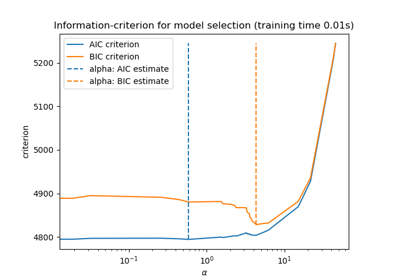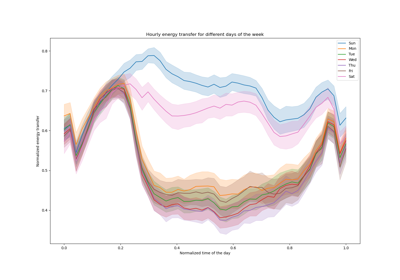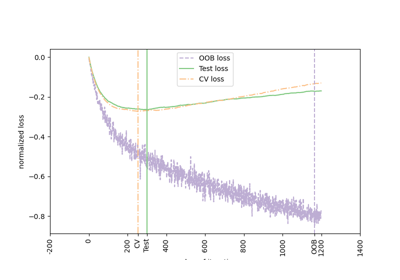Note
Go to the end to download the full example code or to run this example in your browser via JupyterLite or Binder.
Early stopping of Stochastic Gradient Descent#
Stochastic Gradient Descent is an optimization technique which minimizes a loss function in a stochastic fashion, performing a gradient descent step sample by sample. In particular, it is a very efficient method to fit linear models.
As a stochastic method, the loss function is not necessarily decreasing at each iteration, and convergence is only guaranteed in expectation. For this reason, monitoring the convergence on the loss function can be difficult.
Another approach is to monitor convergence on a validation score. In this case, the input data is split into a training set and a validation set. The model is then fitted on the training set and the stopping criterion is based on the prediction score computed on the validation set. This enables us to find the least number of iterations which is sufficient to build a model that generalizes well to unseen data and reduces the chance of over-fitting the training data.
This early stopping strategy is activated if early_stopping=True; otherwise
the stopping criterion only uses the training loss on the entire input data. To
better control the early stopping strategy, we can specify a parameter
validation_fraction which set the fraction of the input dataset that we
keep aside to compute the validation score. The optimization will continue
until the validation score did not improve by at least tol during the last
n_iter_no_change iterations. The actual number of iterations is available
at the attribute n_iter_.
This example illustrates how the early stopping can used in the
SGDClassifier model to achieve almost the same
accuracy as compared to a model built without early stopping. This can
significantly reduce training time. Note that scores differ between the
stopping criteria even from early iterations because some of the training data
is held out with the validation stopping criterion.
No stopping criterion: .................................................
Training loss: .................................................
Validation score: .................................................
# Authors: The scikit-learn developers
# SPDX-License-Identifier: BSD-3-Clause
import sys
import time
import matplotlib.pyplot as plt
import numpy as np
import pandas as pd
from sklearn import linear_model
from sklearn.datasets import fetch_openml
from sklearn.exceptions import ConvergenceWarning
from sklearn.model_selection import train_test_split
from sklearn.utils import shuffle
from sklearn.utils._testing import ignore_warnings
def load_mnist(n_samples=None, class_0="0", class_1="8"):
"""Load MNIST, select two classes, shuffle and return only n_samples."""
# Load data from http://openml.org/d/554
mnist = fetch_openml("mnist_784", version=1, as_frame=False)
# take only two classes for binary classification
mask = np.logical_or(mnist.target == class_0, mnist.target == class_1)
X, y = shuffle(mnist.data[mask], mnist.target[mask], random_state=42)
if n_samples is not None:
X, y = X[:n_samples], y[:n_samples]
return X, y
@ignore_warnings(category=ConvergenceWarning)
def fit_and_score(estimator, max_iter, X_train, X_test, y_train, y_test):
"""Fit the estimator on the train set and score it on both sets"""
estimator.set_params(max_iter=max_iter)
estimator.set_params(random_state=0)
start = time.time()
estimator.fit(X_train, y_train)
fit_time = time.time() - start
n_iter = estimator.n_iter_
train_score = estimator.score(X_train, y_train)
test_score = estimator.score(X_test, y_test)
return fit_time, n_iter, train_score, test_score
# Define the estimators to compare
estimator_dict = {
"No stopping criterion": linear_model.SGDClassifier(n_iter_no_change=3),
"Training loss": linear_model.SGDClassifier(
early_stopping=False, n_iter_no_change=3, tol=0.1
),
"Validation score": linear_model.SGDClassifier(
early_stopping=True, n_iter_no_change=3, tol=0.0001, validation_fraction=0.2
),
}
# Load the dataset
X, y = load_mnist(n_samples=10000)
X_train, X_test, y_train, y_test = train_test_split(X, y, test_size=0.5, random_state=0)
results = []
for estimator_name, estimator in estimator_dict.items():
print(estimator_name + ": ", end="")
for max_iter in range(1, 50):
print(".", end="")
sys.stdout.flush()
fit_time, n_iter, train_score, test_score = fit_and_score(
estimator, max_iter, X_train, X_test, y_train, y_test
)
results.append(
(estimator_name, max_iter, fit_time, n_iter, train_score, test_score)
)
print("")
# Transform the results in a pandas dataframe for easy plotting
columns = [
"Stopping criterion",
"max_iter",
"Fit time (sec)",
"n_iter_",
"Train score",
"Test score",
]
results_df = pd.DataFrame(results, columns=columns)
# Define what to plot
lines = "Stopping criterion"
x_axis = "max_iter"
styles = ["-.", "--", "-"]
# First plot: train and test scores
fig, axes = plt.subplots(nrows=1, ncols=2, sharey=True, figsize=(12, 4))
for ax, y_axis in zip(axes, ["Train score", "Test score"]):
for style, (criterion, group_df) in zip(styles, results_df.groupby(lines)):
group_df.plot(x=x_axis, y=y_axis, label=criterion, ax=ax, style=style)
ax.set_title(y_axis)
ax.legend(title=lines)
fig.tight_layout()
# Second plot: n_iter and fit time
fig, axes = plt.subplots(nrows=1, ncols=2, figsize=(12, 4))
for ax, y_axis in zip(axes, ["n_iter_", "Fit time (sec)"]):
for style, (criterion, group_df) in zip(styles, results_df.groupby(lines)):
group_df.plot(x=x_axis, y=y_axis, label=criterion, ax=ax, style=style)
ax.set_title(y_axis)
ax.legend(title=lines)
fig.tight_layout()
plt.show()
Total running time of the script: (0 minutes 28.933 seconds)
Related examples
